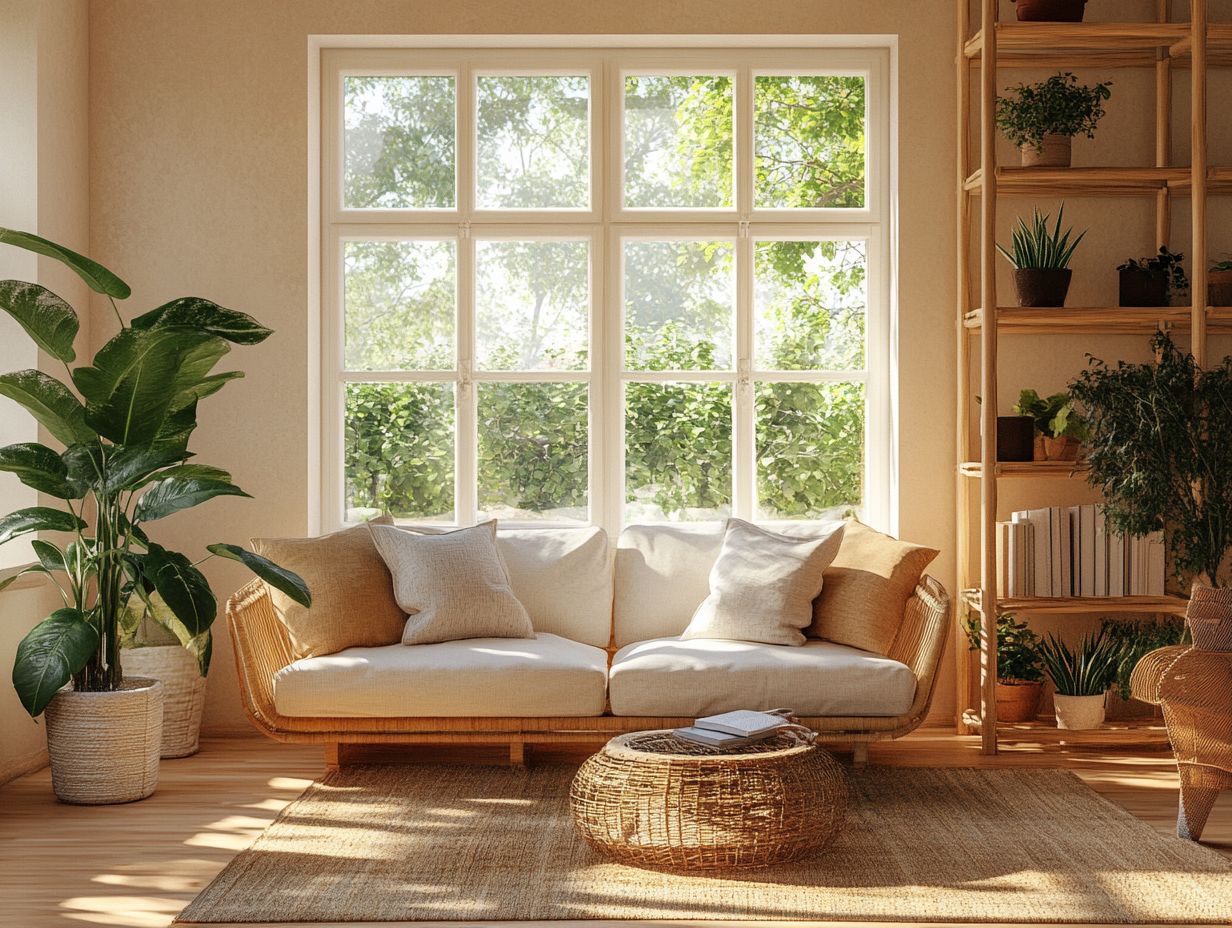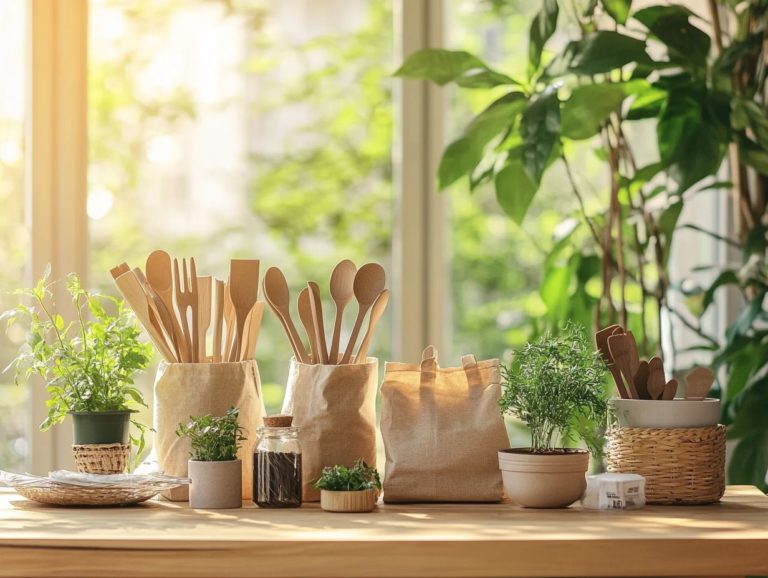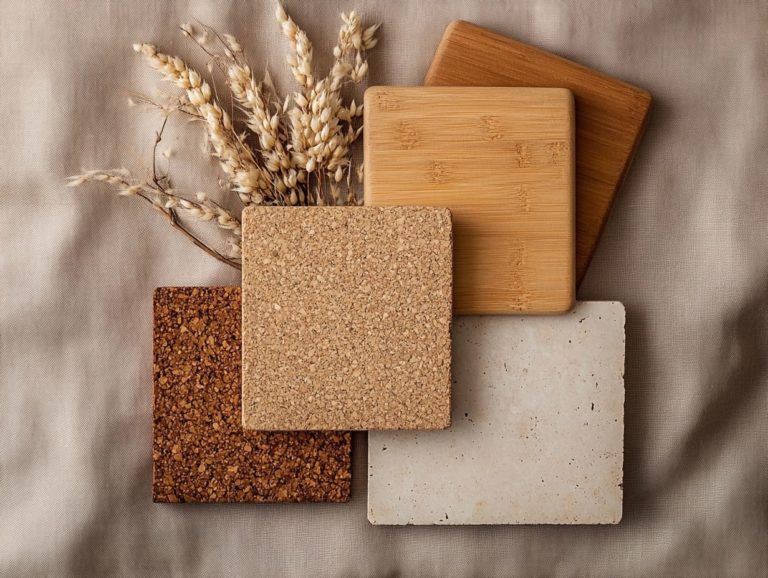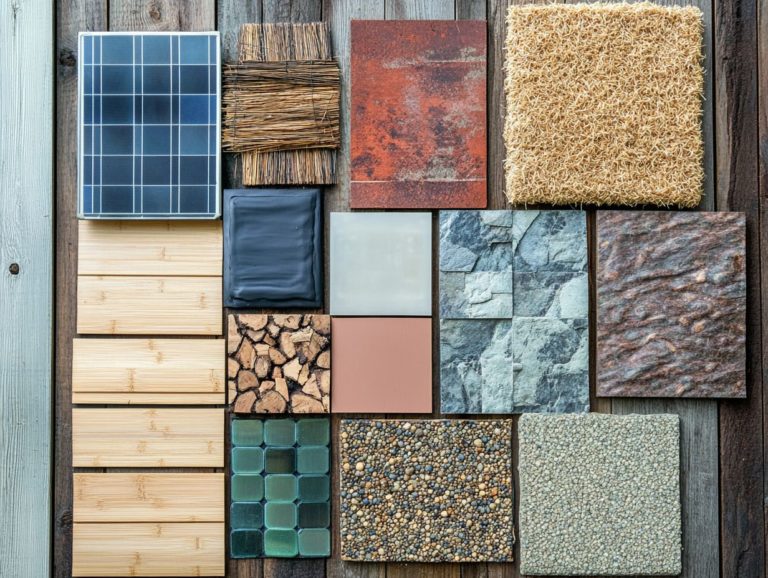How to Maintain Sustainable Home Materials
Building a sustainable home transcends mere aesthetics; it involves making intentional choices that have a positive impact on the environment. Act now to make a difference!
This article delves into the importance of sustainable materials, providing valuable insights into their environmental advantages and guiding you on how to choose wisely.
Discover practical tips for seamlessly integrating these materials into your design, ensuring their integrity, and exploring innovative methods for repurposing them.
Embark on this journey toward a greener home, where each decision you make contributes to a healthier planet.
Contents
- Key Takeaways:
- The Importance of Sustainable Home Materials
- Choosing Sustainable Materials for Your Home
- Incorporating Sustainable Materials in Home Design
- Maintaining Sustainable Materials in Your Home
- Disposing of Sustainable Materials
- Upcycling and Repurposing Materials
- Frequently Asked Questions
- 1. What are sustainable home materials?
- 2. Why is it important to maintain sustainable home materials?
- 3. How can I maintain sustainable home materials?
- 4. What are some examples of sustainable home materials?
- 5. How do sustainable home materials benefit the environment?
- 6. Is it expensive to maintain sustainable home materials?
Key Takeaways:

- Using sustainable materials helps reduce environmental impact.
- Choose materials based on their durability and resource usage.
- Learn proper care techniques to maintain sustainable materials.
The Importance of Sustainable Home Materials
Sustainable home materials are crucial for building today. They help improve energy efficiency and promote eco-friendly practices while reducing environmental harm. For more information, check out what to look for in sustainable home materials.
By adopting ways to manage sustainable materials, you can ensure that the materials you choose are environmentally responsible and economically viable. For example, sourcing local sustainable materials for your home fosters a conscientious approach to urban development and resource conservation.
This dedication to incorporating sustainable building materials not only improves air quality and reduces carbon emissions but also leads to significant energy savings throughout the life of your home.
Environmental Impact and Benefits
The environmental impact of using sustainable building materials is significant, as they are meticulously crafted to minimize carbon emissions and enhance energy savings throughout their entire life cycle.
By choosing these materials, you contribute to reduced waste generation and support energy efficiency from manufacturing to disposal. Take reclaimed wood and bamboo, for example; they are excellent choices that provide durability while requiring less energy to produce compared to traditional lumber.
Incorporating materials like recycled metal and low VOC paints can dramatically improve indoor air quality and further reduce your overall carbon footprint. Utilizing life cycle assessment techniques enables you to evaluate the comprehensive benefits and long-term ecological advantages of these sustainable options, ultimately playing a crucial role in combating climate change and fostering a healthier planet.
Choosing Sustainable Materials for Your Home
When you choose sustainable materials for your home, it’s essential to thoughtfully consider options that align with how to research sustainable materials for your home practices.
This approach enhances the aesthetic value of your space and ensures minimal environmental impact during the construction process.
Factors to Consider
When selecting sustainable building materials, consider several key factors: the source of the materials, their environmental responsibility, and how they contribute to energy-efficient appliances and eco-friendly construction.
Among these considerations, resource conservation takes center stage. By opting for renewable or recycled materials, you can minimize waste and alleviate the pressure on our natural resources. Understanding the environmental impact of materials throughout their lifecycle from extraction to disposal enables you to make informed decisions that align with your sustainability goals.
For example, prioritizing materials with lower carbon footprints not only enhances energy efficiency but also fosters healthier living spaces. These factors resonate with broader principles of sustainable architecture, promoting designs that harmonize with nature, utilize local resources, and support a circular economy, ultimately elevating the sustainability of the built environment.
Start your journey toward a sustainable home today!
Incorporating Sustainable Materials in Home Design

Incorporating sustainable materials into your home design is vital for crafting low-maintenance residences. Learning how to upcycle sustainable materials at home not only supports sustainable architecture but also enhances the aesthetics and functionality of your living spaces.
This thoughtful approach creates an environment that harmonizes with nature. It provides a stylish and practical home for years to come.
Tips for Designing with Sustainability in Mind
Designing with sustainability requires a focus on eco-friendly building materials. It also involves innovative green technologies that minimize energy consumption.
By choosing renewable resources like bamboo, reclaimed wood, or recycled metal, you can significantly lower your carbon footprint. This can be done without sacrificing aesthetic appeal.
It s crucial to consider the entire lifespan of these materials. Evaluate their production, transportation, installation, and eventual disposal.
Sustainable sourcing is key. Opting for locally sourced materials reduces transportation emissions and supports local economies.
Integrating energy-efficient appliances, like solar panels, boosts your home s sustainability. It also fosters a better relationship with the environment.
Maintaining Sustainable Materials in Your Home
Maintaining sustainable materials is essential for ensuring their longevity and effectiveness. This requires a nuanced understanding of sustainable materials management.
By prioritizing these materials, you enhance the durability of your home while also understanding why sustainable materials matter in home design and playing a crucial role in safeguarding the planet for future generations.
Cleaning and Care Tips
Proper cleaning and care of sustainable materials demand specific techniques. Using eco-friendly products aligns with sustainable materials management practices while minimizing negative environmental impacts.
Opting for biodegradable cleaners and natural solutions contributes to a healthier ecosystem. You also extend the lifespan of your belongings.
Bamboo and cork require gentle cleaning agents to avoid wear while maintaining their natural sheen. Organic cotton benefits from mild detergents to preserve its fibers.
Implementing practices like air drying and using low-energy washing cycles can further enhance your sustainability efforts. These conscientious methods protect the integrity of eco-friendly materials.
They ensure these materials remain durable and visually appealing for years to come.
Disposing of Sustainable Materials
Disposing of sustainable materials responsibly is paramount in effective materials management. Ensuring these materials are either reused or recycled actively promotes resource conservation.
This mindful approach not only benefits the environment. It also reflects your values.
Proper Disposal Methods

Proper disposal methods for sustainable materials include recycling and upcycling strategies. These not only diminish waste but also play a crucial role in environmental protection.
By adopting these practices, you can transform items like glass, plastic, and textiles into new products. This effectively extends their life cycle and minimizes contributions to landfills.
For instance, you might strip the labels off glass containers and recycle them into new bottles or even insulation materials. Old textiles can be creatively repurposed into cleaning rags or cozy quilts.
Local resources, such as community recycling centers and educational programs, often offer valuable guidance on these processes. Engaging with local initiatives not only bolsters your sustainability efforts but also nurtures a collective movement toward waste reduction in your community.
Upcycling and Repurposing Materials
Upcycling and repurposing materials offer you new ways to prolong the lifespan of sustainable resources. By embracing these practices, you not only enhance your creativity but also play a vital role in saving resources.
Creative Ways to Reuse Materials in Your Home
Creative ways to reuse materials in your home can turn waste into stunning, functional designs. This amplifies the environmental benefits of sustainable materials through upcycling and repurposing projects.
These endeavors not only infuse everyday items with new life but also foster a mindset focused on sustainability. For example, consider those empty glass jars they can effortlessly transform into chic storage solutions or unique candle holders, adding a touch of charm and practicality to any room.
Old wooden pallets can hold the potential to become rustic furniture, like coffee tables or wall decor. They serve as eye-catching conversation starters while helping to reduce landfill waste.
By weaving these DIY ideas into your daily life, you ll contribute positively to the environment. Sustainability can be both stylish and practical.
Frequently Asked Questions
1. What are sustainable home materials?
Sustainable home materials are those that are environmentally friendly and can be reused, recycled, or biodegraded without causing harm to the environment. Understanding why your home needs more sustainable materials can help you make better choices for the planet.
2. Why is it important to maintain sustainable home materials?

Keeping your home materials sustainable helps cut your carbon footprint! For more insights on this topic, check out sustainable materials: the key to an eco-friendly home. It also reduces waste and saves money in the long run.
3. How can I maintain sustainable home materials?
You can maintain sustainable home materials by choosing products made from natural and renewable materials. For more insights on this, check out how to make your home more sustainable with materials. Properly disposing of waste and repairing or repurposing items instead of buying new ones is also essential.
4. What are some examples of sustainable home materials?
Examples of sustainable home materials include:
- Bamboo flooring
- Recycled glass countertops
- Furniture made from reused wood
- Organic cotton and wool for bedding and furniture
- Low VOC paints for walls
5. How do sustainable home materials benefit the environment?
Sustainable home materials benefit the environment by reducing waste in landfills and conserving natural resources. Understanding why sustainable materials are essential for green homes also helps reduce pollution and greenhouse gas emissions.
6. Is it expensive to maintain sustainable home materials?
At first, it may seem more expensive to invest in sustainable home materials. However, they can save you money through energy efficiency and durability in the long run. For homeowners looking to make informed choices, exploring sustainable materials can significantly reduce waste and help create a healthier, sustainable future for everyone.






